
Q-Chem
@qchemsoftware.bsky.social
Q-Chem provides a comprehensive ab initio quantum chemistry program, allowing scientists worldwide to model chemical problems quickly and accurately.
http://q-chem.com/
http://q-chem.com/
In this preprint, Q-Chem developers introduce two implementations of sRI-CC2 for excited-state analytical gradients and derivative couplings. Their partial sRI-CC2 method, available in Q-Chem 6.4, is significantly faster than traditional RI-CC2 approaches! doi.org/10.48550/arX...

November 7, 2025 at 6:58 PM
In this preprint, Q-Chem developers introduce two implementations of sRI-CC2 for excited-state analytical gradients and derivative couplings. Their partial sRI-CC2 method, available in Q-Chem 6.4, is significantly faster than traditional RI-CC2 approaches! doi.org/10.48550/arX...
In this recent preprint, Q-Chem developers introduce a new method for modeling the XAS of open-shell systems! Their approach, included in the upcoming Q-Chem 6.4 release, yields semi-quantitative K-edge and pre-edge orbital splittings. doi.org/10.26434/che...

November 5, 2025 at 10:11 PM
In this recent preprint, Q-Chem developers introduce a new method for modeling the XAS of open-shell systems! Their approach, included in the upcoming Q-Chem 6.4 release, yields semi-quantitative K-edge and pre-edge orbital splittings. doi.org/10.26434/che...
Join us for an upcoming Q-Chem webinar on November 19th from Manisha, one of our Summer At Q-Chem interns! She will be discussing her work with coupled cluster methods in Q-Chem. Read the abstract and register here: zoom.us/webinar/regi...

November 4, 2025 at 9:36 PM
Join us for an upcoming Q-Chem webinar on November 19th from Manisha, one of our Summer At Q-Chem interns! She will be discussing her work with coupled cluster methods in Q-Chem. Read the abstract and register here: zoom.us/webinar/regi...
In this preprint, authors examine the discrepancy between experimental and theoretical results based on Marcus theory for C-13-ae, using a new scheme (E-SHAKE) to sample the seam between two diabatic electronic states. arxiv.org/pdf/2510.11810
Try Q-Chem: q-chem.com/try/
Try Q-Chem: q-chem.com/try/

November 1, 2025 at 8:33 PM
In this preprint, authors examine the discrepancy between experimental and theoretical results based on Marcus theory for C-13-ae, using a new scheme (E-SHAKE) to sample the seam between two diabatic electronic states. arxiv.org/pdf/2510.11810
Try Q-Chem: q-chem.com/try/
Try Q-Chem: q-chem.com/try/
Researchers accurately model the UV absorption spectrum of the hydroxyl anion in water. They use Q-Chem's CCSD and EOM-CCSD to run highly-accurate QM simulations on clusters generated via MD: doi.org/10.1016/j.mo...
Try Q-Chem today: q-chem.com/try/
Try Q-Chem today: q-chem.com/try/

October 29, 2025 at 8:19 PM
Researchers accurately model the UV absorption spectrum of the hydroxyl anion in water. They use Q-Chem's CCSD and EOM-CCSD to run highly-accurate QM simulations on clusters generated via MD: doi.org/10.1016/j.mo...
Try Q-Chem today: q-chem.com/try/
Try Q-Chem today: q-chem.com/try/
In this recent paper, authors use penalty-constrained geometry optimization and SF-LC-TDDFT in Q-Chem 6.3 to study the fluorescence quenching mechanism of a styrene derivative at a conical intersection: doi.org/10.1021/acso...
Try Q-Chem 6.3 today: q-chem.com/try/
Try Q-Chem 6.3 today: q-chem.com/try/

October 28, 2025 at 8:38 PM
In this recent paper, authors use penalty-constrained geometry optimization and SF-LC-TDDFT in Q-Chem 6.3 to study the fluorescence quenching mechanism of a styrene derivative at a conical intersection: doi.org/10.1021/acso...
Try Q-Chem 6.3 today: q-chem.com/try/
Try Q-Chem 6.3 today: q-chem.com/try/
Can energy decomposition analysis (EDA) be used for excited states? In this recent preprint, Q-Chem developers present an approach for using EDA with ROKS, which is used for single-electron excitations. doi.org/10.26434/che...
Try Q-Chem: q-chem.com/try/
Try Q-Chem: q-chem.com/try/

October 21, 2025 at 10:36 PM
Can energy decomposition analysis (EDA) be used for excited states? In this recent preprint, Q-Chem developers present an approach for using EDA with ROKS, which is used for single-electron excitations. doi.org/10.26434/che...
Try Q-Chem: q-chem.com/try/
Try Q-Chem: q-chem.com/try/
In this preprint, Q-Chem developers extend regularized second order perturbation theory methods to Q-Chem's PBC code for solid state systems (still in development!): arxiv.org/abs/2508.15744
Join our newsletter to be notified when QCPBC is available: q-chem.com/email_signup/
Join our newsletter to be notified when QCPBC is available: q-chem.com/email_signup/

October 13, 2025 at 6:14 PM
In this preprint, Q-Chem developers extend regularized second order perturbation theory methods to Q-Chem's PBC code for solid state systems (still in development!): arxiv.org/abs/2508.15744
Join our newsletter to be notified when QCPBC is available: q-chem.com/email_signup/
Join our newsletter to be notified when QCPBC is available: q-chem.com/email_signup/
Read this preprint in which Manisha and Prashant Uday Manohar present their FNO implementation for EOM-CCSDT for IP, DIP, EA, and DEA. Their implementation is available in Q-Chem 6.3! arxiv.org/pdf/2509.141...
Try FNO-CCSDT yourself in Q-Chem: q-chem.com/try/
Try FNO-CCSDT yourself in Q-Chem: q-chem.com/try/

October 7, 2025 at 4:17 PM
Read this preprint in which Manisha and Prashant Uday Manohar present their FNO implementation for EOM-CCSDT for IP, DIP, EA, and DEA. Their implementation is available in Q-Chem 6.3! arxiv.org/pdf/2509.141...
Try FNO-CCSDT yourself in Q-Chem: q-chem.com/try/
Try FNO-CCSDT yourself in Q-Chem: q-chem.com/try/
Coming soon to Q-Chem: Periodic boundary conditions! Read this preprint from researchers at Harvard, who present a new method for modeling electrochemical interactions at solid-liquid interfaces: doi.org/10.48550/arX...
Learn more about PBC in Q-Chem: q-chem.com/webinars/73/
Learn more about PBC in Q-Chem: q-chem.com/webinars/73/

October 1, 2025 at 8:46 PM
Coming soon to Q-Chem: Periodic boundary conditions! Read this preprint from researchers at Harvard, who present a new method for modeling electrochemical interactions at solid-liquid interfaces: doi.org/10.48550/arX...
Learn more about PBC in Q-Chem: q-chem.com/webinars/73/
Learn more about PBC in Q-Chem: q-chem.com/webinars/73/
Don't miss the next Q-Chem webinar this Friday! Xinchun Wu will be discussing the exciting work she did at Q-Chem this past summer, including constrained CASSCF for studying nonadiabatic systems and tight-binding calculation features. Register here: zoom.us/webinar/regi...

September 30, 2025 at 6:04 PM
Don't miss the next Q-Chem webinar this Friday! Xinchun Wu will be discussing the exciting work she did at Q-Chem this past summer, including constrained CASSCF for studying nonadiabatic systems and tight-binding calculation features. Register here: zoom.us/webinar/regi...
Congratulations to Q-Chem developers on their recent publication, in which they develop non-orthogonal quasi-degenerate perturbation theory to enable XPS calculations for L-edge and beyond! doi.org/10.1021/acs....
Try the new Q-Chem 6.3 release today: q-chem.com/try/
Try the new Q-Chem 6.3 release today: q-chem.com/try/

September 24, 2025 at 8:47 PM
Congratulations to Q-Chem developers on their recent publication, in which they develop non-orthogonal quasi-degenerate perturbation theory to enable XPS calculations for L-edge and beyond! doi.org/10.1021/acs....
Try the new Q-Chem 6.3 release today: q-chem.com/try/
Try the new Q-Chem 6.3 release today: q-chem.com/try/
Q-Chem is pleased to introduce our latest release, Q-Chem 6.3.1! For a full list of updates, fixes, and resolved issues, please review the release log here: q-chem.com/support/rele...
If you want to try Q-Chem 6.3.1, you can request a demo license here: q-chem.com/try/
If you want to try Q-Chem 6.3.1, you can request a demo license here: q-chem.com/try/

September 23, 2025 at 8:04 PM
Q-Chem is pleased to introduce our latest release, Q-Chem 6.3.1! For a full list of updates, fixes, and resolved issues, please review the release log here: q-chem.com/support/rele...
If you want to try Q-Chem 6.3.1, you can request a demo license here: q-chem.com/try/
If you want to try Q-Chem 6.3.1, you can request a demo license here: q-chem.com/try/
In this paper, Q-Chem developers present a novel EOM-CC-based approach for computing Auger decay rates. Their exciting new implementation was done in Q-Chem! doi.org/10.1039/D5CP...
Interested in becoming a Q-Chem developer? Learn more here: q-chem.com/about/team/d...
Interested in becoming a Q-Chem developer? Learn more here: q-chem.com/about/team/d...
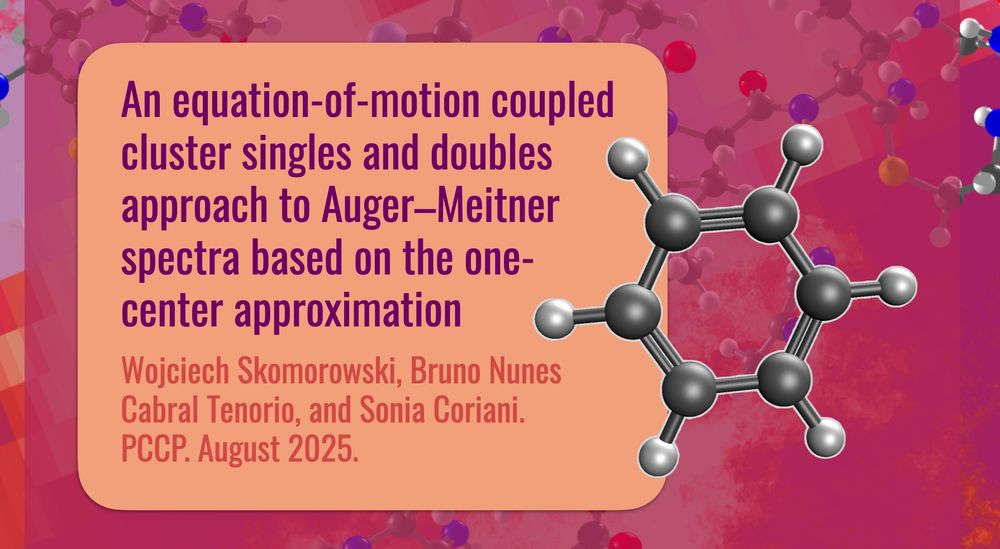
September 15, 2025 at 7:48 PM
In this paper, Q-Chem developers present a novel EOM-CC-based approach for computing Auger decay rates. Their exciting new implementation was done in Q-Chem! doi.org/10.1039/D5CP...
Interested in becoming a Q-Chem developer? Learn more here: q-chem.com/about/team/d...
Interested in becoming a Q-Chem developer? Learn more here: q-chem.com/about/team/d...
Q-Chem developers use TDDFT-1D in Q-Chem to study the photodynamics of TCNE-HMB, gaining useful insights with exciting implications for the applicability of Marcus theory to photochemistry in non-innocent solvents. doi.org/10.1021/acs....
Try Q-Chem: q-chem.com/try/
Try Q-Chem: q-chem.com/try/

September 12, 2025 at 8:58 PM
Q-Chem developers use TDDFT-1D in Q-Chem to study the photodynamics of TCNE-HMB, gaining useful insights with exciting implications for the applicability of Marcus theory to photochemistry in non-innocent solvents. doi.org/10.1021/acs....
Try Q-Chem: q-chem.com/try/
Try Q-Chem: q-chem.com/try/
In this paper, KS-DFT and TAO-DFT in Q-Chem are used to study vibrational stabilization in cyclacene carbon nanobelts. Static correlation (via TAO-DFT) is found to be essential for an accurate description. doi.org/10.1021/acs....
Learn about TAO-DFT: q-chem.com/explore/dft/...
Learn about TAO-DFT: q-chem.com/explore/dft/...

September 8, 2025 at 7:57 PM
In this paper, KS-DFT and TAO-DFT in Q-Chem are used to study vibrational stabilization in cyclacene carbon nanobelts. Static correlation (via TAO-DFT) is found to be essential for an accurate description. doi.org/10.1021/acs....
Learn about TAO-DFT: q-chem.com/explore/dft/...
Learn about TAO-DFT: q-chem.com/explore/dft/...
Don't miss tomorrow's webinar from Mathew Chow! He will discuss NEO-DFT and real-time NEO-TDDFT methods, along with NEO quantum mechanical/molecular mechanical approaches. Register: zoom.us/webinar/regi...

August 20, 2025 at 8:33 PM
Don't miss tomorrow's webinar from Mathew Chow! He will discuss NEO-DFT and real-time NEO-TDDFT methods, along with NEO quantum mechanical/molecular mechanical approaches. Register: zoom.us/webinar/regi...
Join us next week for the 2025 Wormit Award Webinar, to be presented by awardee Mathew Chow! He will discuss NEO-DFT and real-time NEO-TDDFT methods, along with NEO quantum mechanical/molecular mechanical approaches. Register here: zoom.us/webinar/regi...

August 13, 2025 at 8:42 PM
Join us next week for the 2025 Wormit Award Webinar, to be presented by awardee Mathew Chow! He will discuss NEO-DFT and real-time NEO-TDDFT methods, along with NEO quantum mechanical/molecular mechanical approaches. Register here: zoom.us/webinar/regi...
As the academic year starts back up again, don't forget about Q-Chem teaching and learning resources! We provide a variety of free resources on our website, including labs, webinars, and course materials from previous Q-chem workshops. Check it out here: www.q-chem.com/learn/

August 11, 2025 at 7:21 PM
As the academic year starts back up again, don't forget about Q-Chem teaching and learning resources! We provide a variety of free resources on our website, including labs, webinars, and course materials from previous Q-chem workshops. Check it out here: www.q-chem.com/learn/
Join us on July 31 at 11AM for our Nick Besley Award Webinar! The webinar will be presented by award winner Prof. Justin Talbot; he will be discussing his recent work on developing methods for studying excited state potential energy surfaces. Register: zoom.us/webinar/regi...
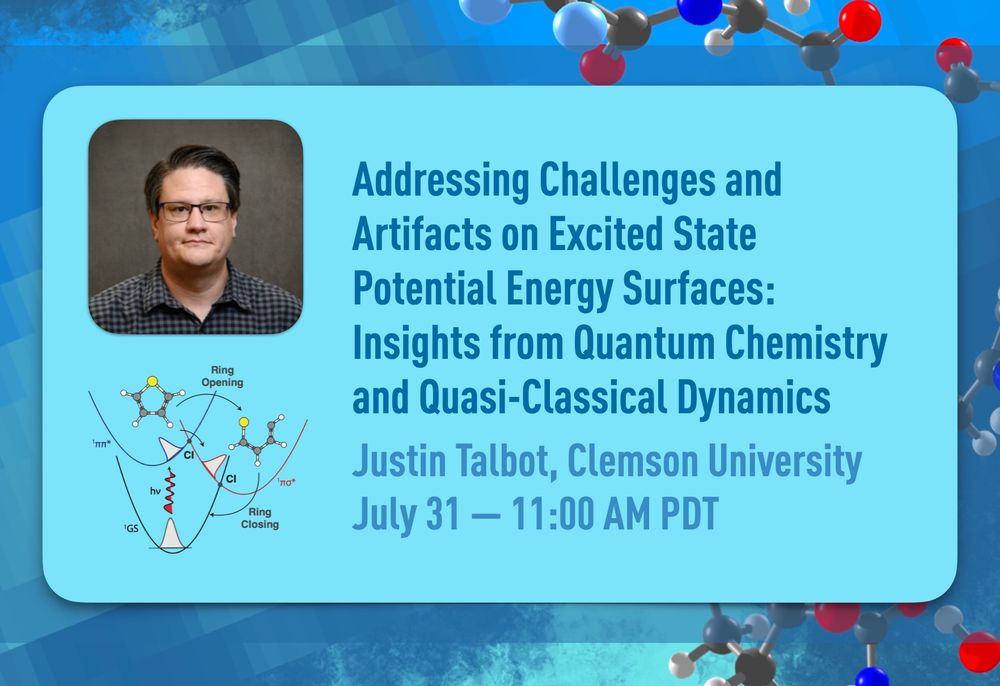
July 30, 2025 at 10:55 PM
Join us on July 31 at 11AM for our Nick Besley Award Webinar! The webinar will be presented by award winner Prof. Justin Talbot; he will be discussing his recent work on developing methods for studying excited state potential energy surfaces. Register: zoom.us/webinar/regi...
Q-Chem was honored to be one of the sponsors of the 2025 MERCURY Conference at UPitt last week! We were excited to hear the multitude of ways that many of these students and professors are using Q-Chem in their ongoing research work. Thanks to those who stopped by!
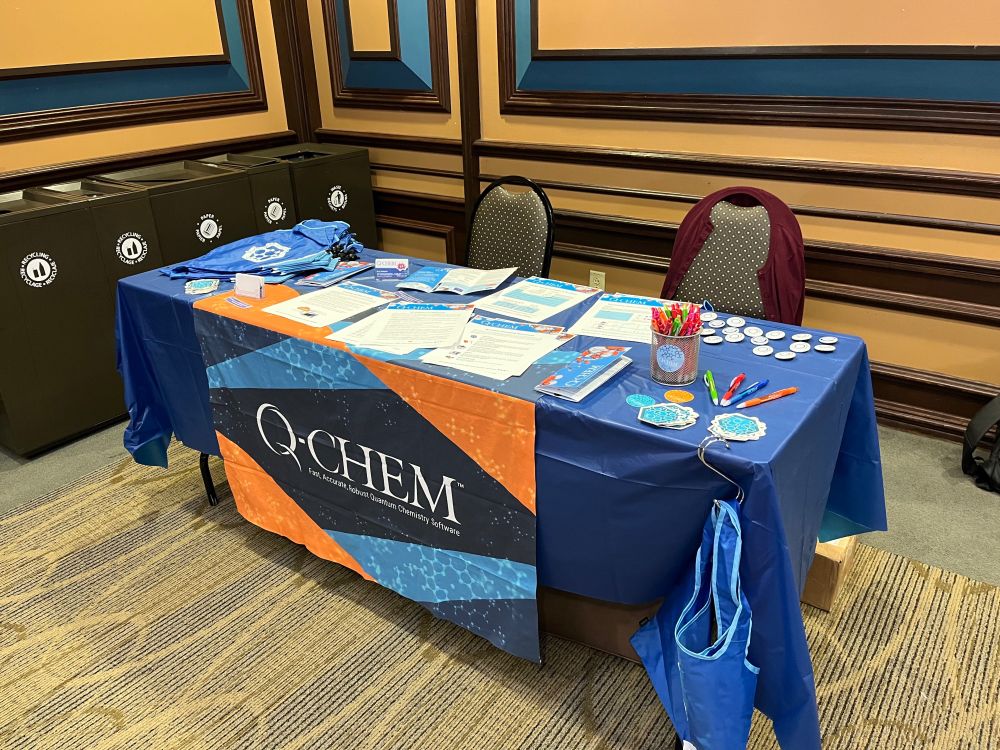
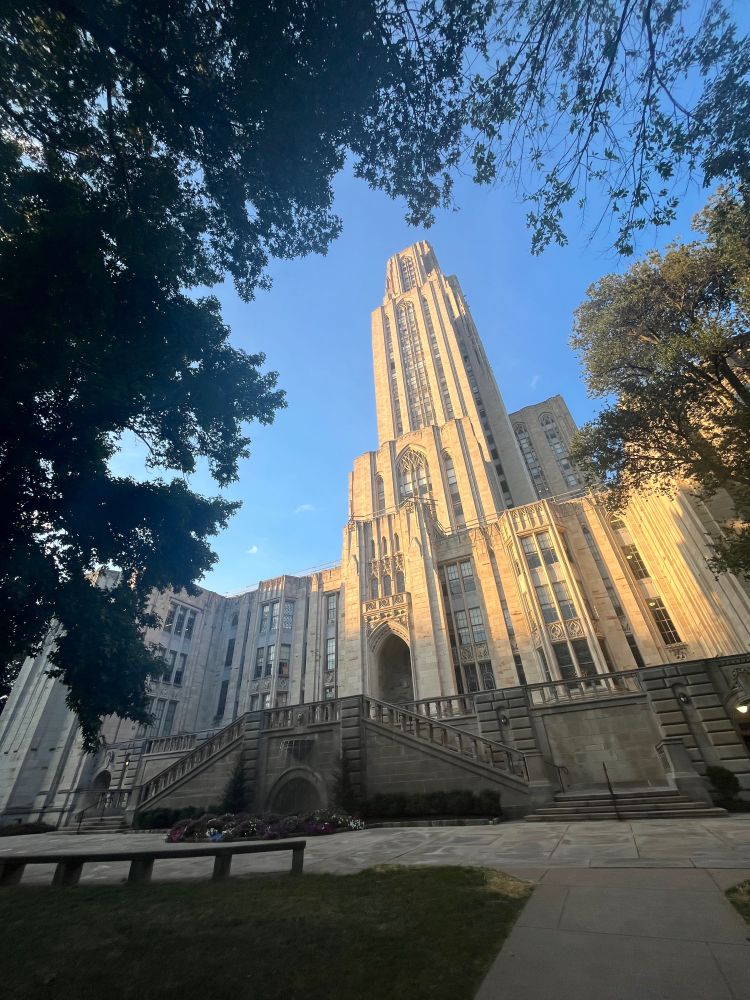
July 28, 2025 at 11:58 PM
Q-Chem was honored to be one of the sponsors of the 2025 MERCURY Conference at UPitt last week! We were excited to hear the multitude of ways that many of these students and professors are using Q-Chem in their ongoing research work. Thanks to those who stopped by!
Congratulations to Q-Chem developers and collaborators on their PCCP Hot Paper!
From author Xiao Liu: "In this work, we present a thorough investigation into the unexpectedly large RMSDs for the ωB97X-D3 functional previously reported on the RDB7 dataset (~12,000 reactions)..." (🧵1/4)
From author Xiao Liu: "In this work, we present a thorough investigation into the unexpectedly large RMSDs for the ωB97X-D3 functional previously reported on the RDB7 dataset (~12,000 reactions)..." (🧵1/4)

July 21, 2025 at 5:28 PM
Congratulations to Q-Chem developers and collaborators on their PCCP Hot Paper!
From author Xiao Liu: "In this work, we present a thorough investigation into the unexpectedly large RMSDs for the ωB97X-D3 functional previously reported on the RDB7 dataset (~12,000 reactions)..." (🧵1/4)
From author Xiao Liu: "In this work, we present a thorough investigation into the unexpectedly large RMSDs for the ωB97X-D3 functional previously reported on the RDB7 dataset (~12,000 reactions)..." (🧵1/4)
Authors investigate electron scattering in nitrous oxide, using Q-Chem's CAP-EOM-EA-CCSD and ezFCF to explain features of the experimentally-observed experimental two-dimensional electron energy loss (EELS) spectra. doi.org/10.26434/chemrxiv-2025-m5dnl

July 17, 2025 at 6:13 PM
Authors investigate electron scattering in nitrous oxide, using Q-Chem's CAP-EOM-EA-CCSD and ezFCF to explain features of the experimentally-observed experimental two-dimensional electron energy loss (EELS) spectra. doi.org/10.26434/chemrxiv-2025-m5dnl
In this recent paper, Q-Chem developers calculate gradients of localized diabatic state energies and couplings at minimum cost. Their approach provides significant savings, benefitting researchers studying electronic relaxation and electron transfer. doi.org/10.1063/5.02...
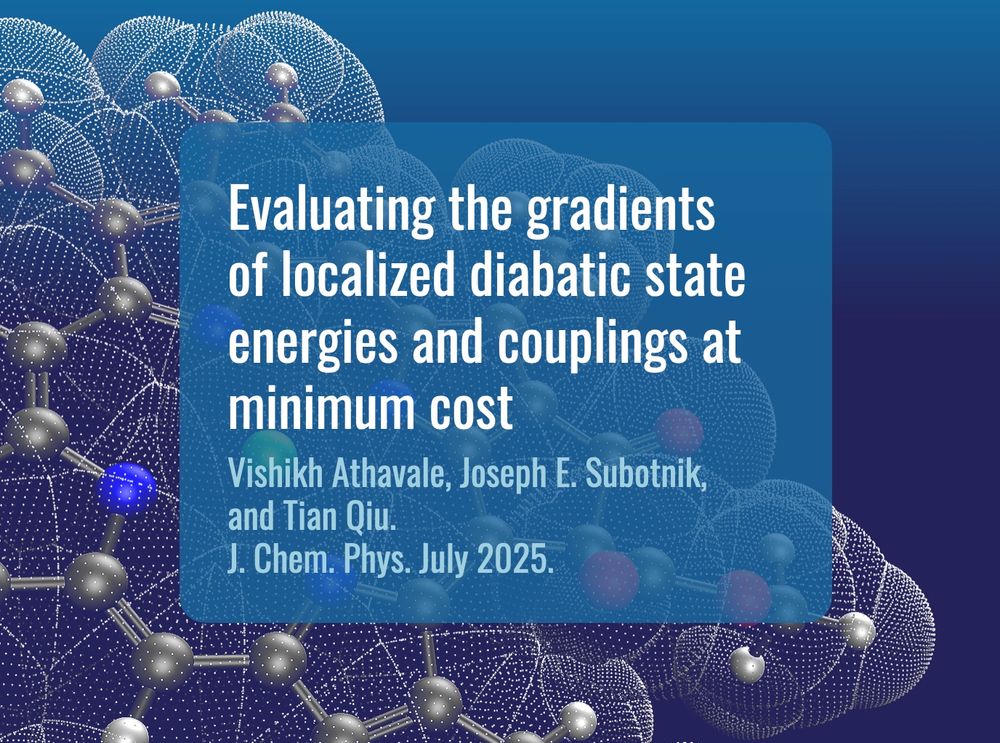
July 15, 2025 at 5:16 PM
In this recent paper, Q-Chem developers calculate gradients of localized diabatic state energies and couplings at minimum cost. Their approach provides significant savings, benefitting researchers studying electronic relaxation and electron transfer. doi.org/10.1063/5.02...
Did you know that Q-Chem's TD-DFT engine has spin-orbit coupling? Calculate L- and M-edge X-ray and XUV spectra at very low cost! doi.org/10.1039/D5CP...
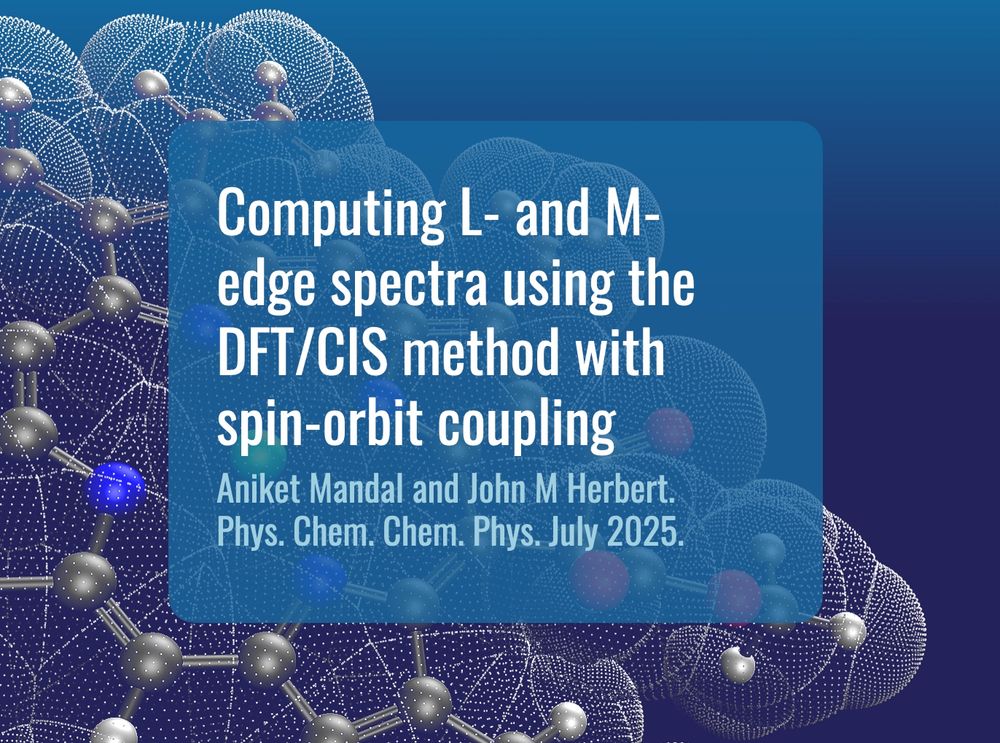
July 14, 2025 at 5:59 PM
Did you know that Q-Chem's TD-DFT engine has spin-orbit coupling? Calculate L- and M-edge X-ray and XUV spectra at very low cost! doi.org/10.1039/D5CP...

